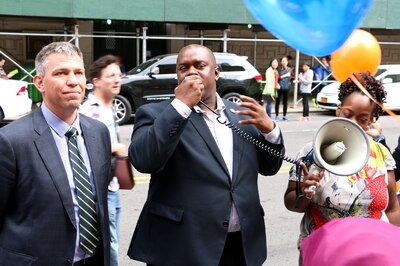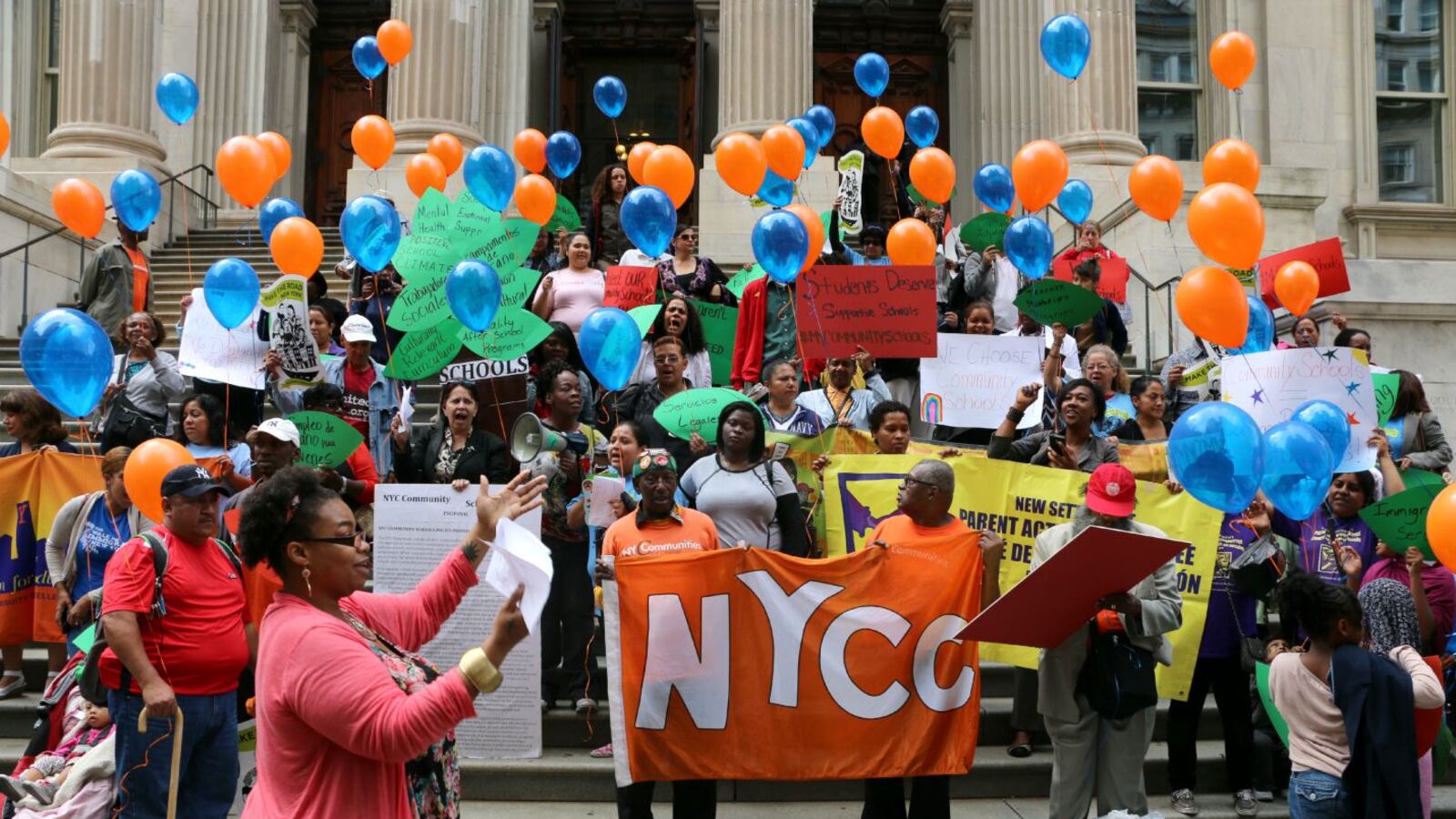Armed with orange and blue balloons, a throng of parents and children converged on the education department headquarters this week chanting, “We want, we need, a community school policy.”
Within minutes, a top city official approached the crowd, borrowed an organizer’s bullhorn, and said the city had heard their demand: The policy was on its way.
Though it appeared spontaneous, the announcement had been carefully choreographed.
The rally’s organizers had told the city in advance about Tuesday’s event, which would center on their demand for the city to adopt a formal definition of a “community school,” something advocates had been calling for since December. The city could either unveil those guidelines at the event or explain to parents why none existed. Ahead of the rally, the organizers received word that Deputy Mayor Richard Buery would stop by the event to announce the guidelines.
“We support the mayor, we support this agenda, but we’re an advocacy group,” said Zakiyah Ansari, advocacy director of the Alliance for Quality Education, one of the groups at the rally.
Such is the intricate dance between advocates who for years fought for funding to fill schools with support services for students and their families, and an administration that has adopted that “community schools” approach as one of its central education initiatives.
For the advocates, the challenge is to back Mayor Bill de Blasio’s ambitious plan to transform nearly 130 schools into community schools, while also ensuring that those changes are made with public input and result in service-filled schools that outlive this mayoral administration. For de Blasio’s side, the trick is to move quickly enough that the public sees an immediate return on its expensive investment while ensuring the continued support of advocates.
The guidelines will become increasingly important as the administration promises to keep creating more of the schools — a plan attracting national attention — and as critics begin assessing their success.
“It’s very important that we are clear about what a community school is, what the standards of implementation are,” Buery told the receptive crowd. “We don’t want a situation where you are not engaging parents, you are not providing services, but you’re still calling it a community school.”
The guidelines that Buery announced Tuesday have not yet been publicly released, but they were sent to the city’s education oversight panel to vote on by the end of the year, a spokesman said. They will become education department guidelines, similar to those around social-media use and student grade promotion.
They are modeled on a framework produced by advocates that listed three core components of these schools — strong academics, support services, and parent participation — along with essential features like a full-time coordinator and dedicated space in the schools for partner organizations.

The guidelines get at a peculiar feature of community schools. Unlike a standardized math program, for instance, which should look similar in every classroom, the services and strategies in each community school should spring from the particular needs of local students and their families.
Therefore, Buery explained, the city’s guidelines are “mostly about being clear on the purpose and the strategy, more than a sort of checklist of what you’ll see in every building.”
They also will help address another challenge for the city: creating some consistency across the wide variety of schools using the community schools approach. This year, those include schools with attendance problems that applied for funding to become community schools; low-performing schools in the city’s “Renewal” turnaround program that were required to adopt the approach; and schools that have been using this approach for years without formal support from the city.
Still, community school proponents have concerns about the city’s efforts that are unlikely to be resolved by the brief guidelines.
Most prominently, they have repeatedly said that in addition to giving schools new services, the city must also aggressively address the schools’ academics. While the Renewal program includes an academic component, it is unclear how the city will make similar changes at the other community schools.
Christopher Caruso, who heads the education department’s new community schools office and also stopped by the rally, said that all city schools get academic support and that “strong instructional practices” are a key part of community schools. Other officials have said that community schools’ exciting extracurricular programs and support services will get more students showing up to class ready to learn, which is the first step toward academic gains.
But advocates insist that programs meant to improve student attendance and wellness must be paired with changes in the classroom.
“You can’t get kids to come to school if their classes suck,” said one advocate, who spoke on the condition of anonymity to avoid straining ties with the administration.
Even if the academics question remains unsettled, the new community schools are already seeing other early signs of progress, parents and educators said.
At Brooklyn Gardens Elementary School, which won one of the community school grants, students now have access to free glasses, dental screenings, and a food pantry, said Afton Vermeer, the school’s social work director. They have started to go on monthly field trips to hiking trails and apple orchards, and staffers have helped students’ families move from homeless shelters to permanent housing.
Vermeer, who works in the school through the nonprofit Partnership With Children, said she supports the community school approach because she has seen what happens when schools lack those services.
“I see kids who don’t have breakfast, or who don’t have stability at home, and don’t have any emotional stability,” she said, “and of course they don’t learn.”

